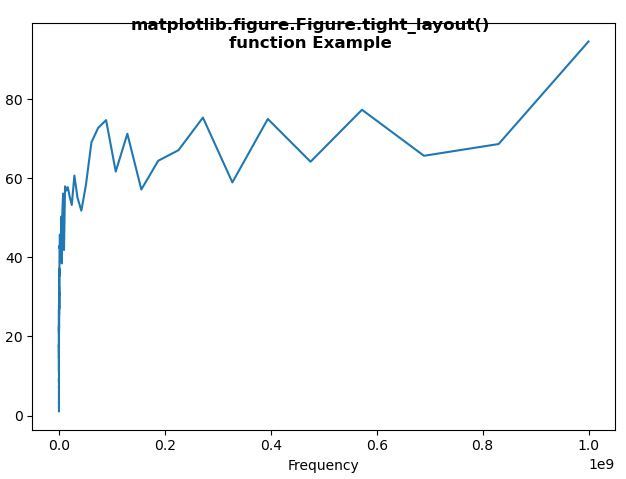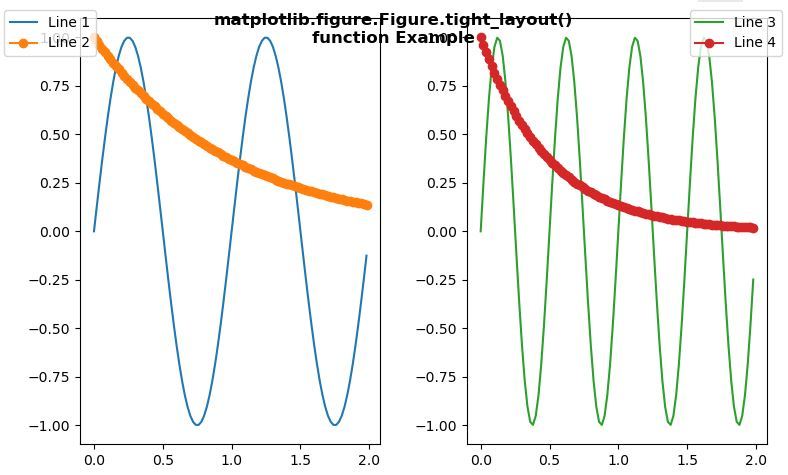Matplotlib是Python中的一个库,它是数字的-NumPy库的数学扩展。 Figure模块提供了顶层Artist,即Figure,其中包含所有绘图元素。此模块用于控制所有图元的子图和顶层容器的默认间距。
matplotlib.figure.Figure.tight_layout()方法
matplotlib库的tight_layout()方法图形模块用于自动调整子图参数以提供指定的填充。
用法:tight_layout(self, renderer=None, pad=1.08, h_pad=None, w_pad=None, rect=None)
参数:此方法接受下面讨论的以下参数:
- renderer:此参数是RendererBase的子类。
- pad:此参数用于在图形边和子图的边之间进行填充,以字体大小的一部分表示。
- h_pad,w_pad:这些参数用于相邻子图的边之间的填充(高度/宽度),作为字体大小的一部分。
- rect:此参数是整个子图区域将适合的归一化图形坐标中的矩形。
返回值:此方法不返回任何值。
以下示例说明了matplotlib.figure中的matplotlib.figure.Figure.tight_layout()函数:
范例1:
import matplotlib.pyplot as plt
import numpy as np
from matplotlib.ticker import EngFormatter
prng = np.random.RandomState(19680801)
xs = np.logspace(1, 9, 100)
ys = (0.8 + 0.4 * prng.uniform(size = 100)) * np.log10(xs)**2
plt.xscale('log')
fig = plt.figure()
ax = fig.subplots()
formatter0 = EngFormatter(unit ='Hz')
ax.plot(xs, ys)
ax.set_xlabel('Frequency')
fig.tight_layout()
fig.suptitle("""matplotlib.figure.Figure.tight_layout()
function Example\n\n""", fontweight ="bold")
fig.show()输出:

范例2:
import numpy as np
import matplotlib.pyplot as plt
fig, axs = plt.subplots(1, 2)
x = np.arange(0.0, 2.0, 0.02)
y1 = np.sin(2 * np.pi * x)
y2 = np.exp(-x)
l1, = axs[0].plot(x, y1)
l2, = axs[0].plot(x, y2, marker ='o')
y3 = np.sin(4 * np.pi * x)
y4 = np.exp(-2 * x)
l3, = axs[1].plot(x, y3, color ='tab:green')
l4, = axs[1].plot(x, y4, color ='tab:red', marker ='o')
fig.legend((l1, l2), ('Line 1', 'Line 2'), 'upper left')
fig.legend((l3, l4), ('Line 3', 'Line 4'), 'upper right')
fig.tight_layout()
fig.suptitle("""matplotlib.figure.Figure.tight_layout()
function Example\n\n""", fontweight ="bold")
fig.show()输出:

相关用法
注:本文由纯净天空筛选整理自SHUBHAMSINGH10大神的英文原创作品 Matplotlib.figure.Figure.tight_layout() in Python。非经特殊声明,原始代码版权归原作者所有,本译文未经允许或授权,请勿转载或复制。
